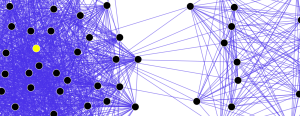
As we move towards more epistemological discussions on the existence and organization of the Internet, measuring the volume of information received by this open repository appears as a necessary action. The idea of digital preservation emerges with challenges developed on our daily lives as users of this web. Because of the uncertainty on how the Internet works, and the companies and governments rule the web space, questions such as “What would it be like to write history when faced by an essentially complete historical record?”(Rosenzweig, Scarcity or Abundance?) is relevant to guide us on the way we act online as historians. The phenomena of “astonishingly rapid accumulation of digital data” (Rosenzweig, Scarcity or Abundance?) seriously affects in several different ways lives of not only scholars, but users in general.
The Internet develops in unknown ways in which information accumulates and at the same time it gets lost. More people has access and more people know how to navigate on it. No wonder Rosenzweig states that “Digital sky surveys, for example, access over 2 billion images. Even a dozen years ago, NASA already had 1.2 million magnetic tapes (many of them poorly maintained and documented) with space data.” The amount of information out there today grew also with the protagonism of social media (Twitter, Tumblr, Instagram etc.). In this case you can see a live stream of information flowing in front of your eyes.
No wonder gigantic tech companies like Google, Yahoo, AOL; internet providers like Comcast and Time Warner Cable; and national governments are always trying to regulate and control users, content, and ways of using and interacting through Internet. History remains, always remained and will always remain in dispute. Times are fluid. Information and capital flow faster and easily than 50, 10, 5 years ago. If entire websites can be erased from the Internet, well, that’s how technology always worked, it shifts its shape far away from the masses: The digital world was born as a secret scholarly project.
But beyond these institutions, the abundance in itself already regulates what we can see and cannot see. The flood of data and information we are exposed opens a new world for us everyday, but also shuts down several other worlds. Just like historiography, digital preservation needs to deal with silences in history.
And by that I mean that silences can enter the process of historical production at four crucial moments:
“The moment of fact creation (the making of sources)
The moment of fact assembly (the making of archives)
The moment of fact retrieval (the making of narratives)
The moment of retrospective significance (the making of history in the final instance)” (Michel-Rolph Truillot, Silencing the Past, 26).
I understand that these silences are inevitable on the digital preservation too. Maybe, there’s a niche for digital historians there. A path to research the online silences: What gets lost? What gets blocked? What gets censored? On a different perspective, there’s also a niche for digital historians on researching publications: What gets published? What is released? What is leaked? Why? How? And so what? are still important questions in this realm of research. Now more than ever this debate is part of our daily lives as big actors on the world wide web such as Wikileaks, PRISM, NSA, Anonymous, and many others are super active.

I’m fascinated by your idea that digital historians could adapt Trulliot’s ideas of
“The moment of fact creation (the making of sources)
The moment of fact assembly (the making of archives)
The moment of fact retrieval (the making of narratives)”
This would in some ways pare down the amount of information (perhaps meaningfully) we have digitally, and more importantly, would also force us to carefully interrogate digital creation, which is something I think is sometimes absent from evaluations of digital history theory and practice (though I would say its generally present in more document based history). In the future, I can absolutely see a group of historians just focusing on the digital retrieval aspect in terms of how historians learn about the past and how they assemble information. Exciting possibilities!
I am stunned by the way you came up with the four points for historians to enter the process. Furthermore, I hope that we can get some answers on the questions you posed in your last paragraph since left some of them open too in my blog post.